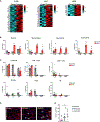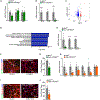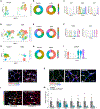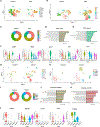Muscle inflammation is regulated by NF-κB from multiple cells to control distinct states of wasting in cancer cachexia
- PMID: 39475511
- PMCID: PMC11774514
- DOI: 10.1016/j.celrep.2024.114925
Muscle inflammation is regulated by NF-κB from multiple cells to control distinct states of wasting in cancer cachexia
Abstract
Although cancer cachexia is classically characterized as a systemic inflammatory disorder, emerging evidence indicates that weight loss also associates with local tissue inflammation. We queried the regulation of this inflammation and its causality to cachexia by exploring skeletal muscle, whose atrophy strongly associates with poor outcomes. Using multiple mouse models and patient samples, we show that cachectic muscle is marked by enhanced innate immunity. Nuclear factor κB (NF-κB) activity in multiple cells, including satellite cells, myofibers, and fibro-adipogenic progenitors, promotes macrophage expansion equally derived from infiltrating monocytes and resident cells. Moreover, NF-κB-activated cells and macrophages undergo crosstalk; NF-κB+ cells recruit macrophages to inhibit regeneration and promote atrophy but, interestingly, also protect myofibers, while macrophages stimulate NF-κB+ cells to sustain an inflammatory feedforward loop. Together, we propose that NF-κB functions in multiple cells in the muscle microenvironment to stimulate macrophages that both promote and protect against muscle wasting in cancer.
Keywords: CP: Cancer; CP: Immunology; NF-κB; cancer cachexia; fibro-adipogenic progenitors; macrophages; muscle progenitor cells; pancreatic cancer.
Copyright © 2024 The Author(s). Published by Elsevier Inc. All rights reserved.
Conflict of interest statement
Declaration of interests T.A.Z. is a scientific advisory board member of Emmyon, Inc. and PeleOS, LLC.
Figures







References
Publication types
MeSH terms
Substances
Associated data
- Actions
- Actions
- Actions
Grants and funding
LinkOut - more resources
Full Text Sources
Medical
Molecular Biology Databases
Miscellaneous

